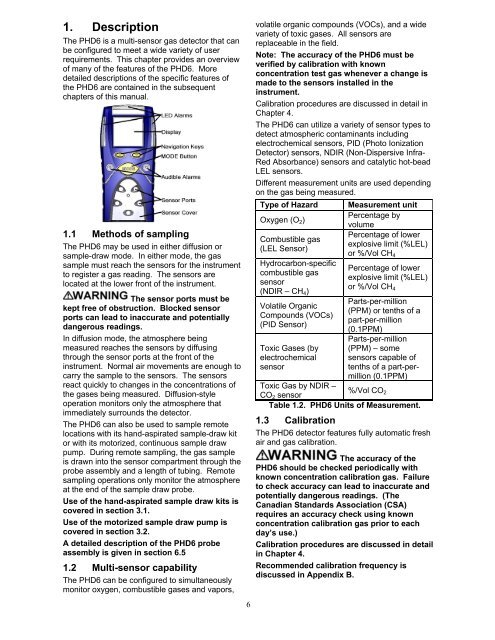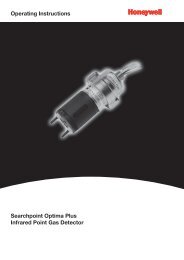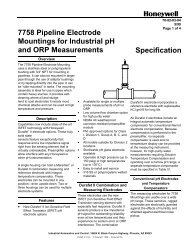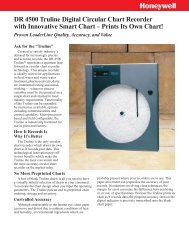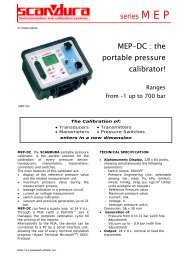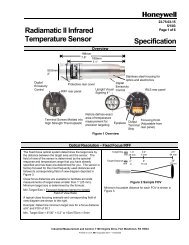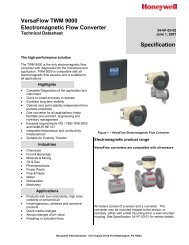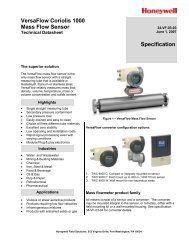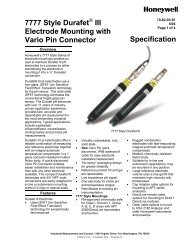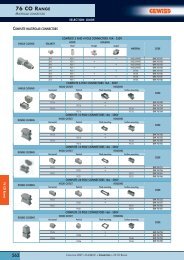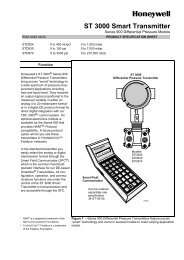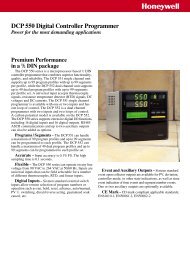PhD6 Multi-Gas Detector Reference Manual - Honeywell Analytics
PhD6 Multi-Gas Detector Reference Manual - Honeywell Analytics
PhD6 Multi-Gas Detector Reference Manual - Honeywell Analytics
Create successful ePaper yourself
Turn your PDF publications into a flip-book with our unique Google optimized e-Paper software.
1. DescriptionThe PHD6 is a multi-sensor gas detector that canbe configured to meet a wide variety of userrequirements. This chapter provides an overviewof many of the features of the PHD6. Moredetailed descriptions of the specific features ofthe PHD6 are contained in the subsequentchapters of this manual.1.1 Methods of samplingThe PHD6 may be used in either diffusion orsample-draw mode. In either mode, the gassample must reach the sensors for the instrumentto register a gas reading. The sensors arelocated at the lower front of the instrument.The sensor ports must bekept free of obstruction. Blocked sensorports can lead to inaccurate and potentiallydangerous readings.In diffusion mode, the atmosphere beingmeasured reaches the sensors by diffusingthrough the sensor ports at the front of theinstrument. Normal air movements are enough tocarry the sample to the sensors. The sensorsreact quickly to changes in the concentrations ofthe gases being measured. Diffusion-styleoperation monitors only the atmosphere thatimmediately surrounds the detector.The PHD6 can also be used to sample remotelocations with its hand-aspirated sample-draw kitor with its motorized, continuous sample drawpump. During remote sampling, the gas sampleis drawn into the sensor compartment through theprobe assembly and a length of tubing. Remotesampling operations only monitor the atmosphereat the end of the sample draw probe.Use of the hand-aspirated sample draw kits iscovered in section 3.1.Use of the motorized sample draw pump iscovered in section 3.2.A detailed description of the PHD6 probeassembly is given in section 6.51.2 <strong>Multi</strong>-sensor capabilityThe PHD6 can be configured to simultaneouslymonitor oxygen, combustible gases and vapors,6volatile organic compounds (VOCs), and a widevariety of toxic gases. All sensors arereplaceable in the field.Note: The accuracy of the PHD6 must beverified by calibration with knownconcentration test gas whenever a change ismade to the sensors installed in theinstrument.Calibration procedures are discussed in detail inChapter 4.The PHD6 can utilize a variety of sensor types todetect atmospheric contaminants includingelectrochemical sensors, PID (Photo Ionization<strong>Detector</strong>) sensors, NDIR (Non-Dispersive Infra-Red Absorbance) sensors and catalytic hot-beadLEL sensors.Different measurement units are used dependingon the gas being measured.Type of Hazard Measurement unitPercentage byOxygen (O 2 )Combustible gas(LEL Sensor)Hydrocarbon-specificcombustible gassensor(NDIR – CH 4 )Volatile OrganicCompounds (VOCs)(PID Sensor)Toxic <strong>Gas</strong>es (byelectrochemicalsensorvolumePercentage of lowerexplosive limit (%LEL)or %/Vol CH 4Percentage of lowerexplosive limit (%LEL)or %/Vol CH 4Parts-per-million(PPM) or tenths of apart-per-million(0.1PPM)Parts-per-million(PPM) – somesensors capable oftenths of a part-permillion(0.1PPM)Toxic <strong>Gas</strong> by NDIR –%/Vol COCO 2 sensor2Table 1.2. PHD6 Units of Measurement.1.3 CalibrationThe PHD6 detector features fully automatic freshair and gas calibration.The accuracy of thePHD6 should be checked periodically withknown concentration calibration gas. Failureto check accuracy can lead to inaccurate andpotentially dangerous readings. (TheCanadian Standards Association (CSA)requires an accuracy check using knownconcentration calibration gas prior to eachday’s use.)Calibration procedures are discussed in detailin Chapter 4.Recommended calibration frequency isdiscussed in Appendix B.


